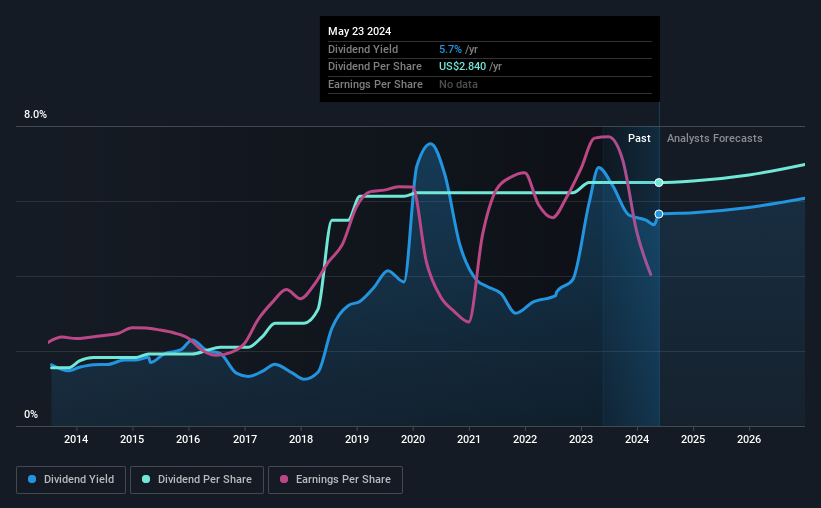Comerica's (NYSE:CMA) Dividend Will Be $0.71
Comerica Incorporated (NYSE:CMA) has announced that it will pay a dividend of $0.71 per share on the 1st of July. This means the annual payment is 5.7% of the current stock price, which is above the average for the industry.
View our latest analysis for Comerica
Comerica's Payment Expected To Have Solid Earnings Coverage
Impressive dividend yields are good, but this doesn't matter much if the payments can't be sustained.
Comerica has a long history of paying out dividends, with its current track record at a minimum of 10 years. Past distributions do not necessarily guarantee future ones, but Comerica's payout ratio of 56% is a good sign as this means that earnings decently cover dividends.
The next 3 years are set to see EPS grow by 28.8%. The future payout ratio could be 50% over that time period, according to analyst estimates, which is a good look for the future of the dividend.
Comerica Has A Solid Track Record
The company has been paying a dividend for a long time, and it has been quite stable which gives us confidence in the future dividend potential. Since 2014, the dividend has gone from $0.68 total annually to $2.84. This implies that the company grew its distributions at a yearly rate of about 15% over that duration. So, dividends have been growing pretty quickly, and even more impressively, they haven't experienced any notable falls during this period.
Dividend Growth Is Doubtful
Investors who have held shares in the company for the past few years will be happy with the dividend income they have received. However, things aren't all that rosy. In the last five years, Comerica's earnings per share has shrunk at approximately 8.4% per annum. If earnings continue declining, the company may have to make the difficult choice of reducing the dividend or even stopping it completely - the opposite of dividend growth. Earnings are forecast to grow over the next 12 months and if that happens we could still be a little bit cautious until it becomes a pattern.
In Summary
In summary, we are pleased with the dividend remaining consistent, and we think there is a good chance of this continuing in the future. The earnings coverage is acceptable for now, but with earnings on the decline we would definitely keep an eye on the payout ratio. Taking all of this into consideration, the dividend looks viable moving forward, but investors should be mindful that the company has pushed the boundaries of sustainability in the past and may do so again.
It's important to note that companies having a consistent dividend policy will generate greater investor confidence than those having an erratic one. Still, investors need to consider a host of other factors, apart from dividend payments, when analysing a company. As an example, we've identified 2 warning signs for Comerica that you should be aware of before investing. Looking for more high-yielding dividend ideas? Try our collection of strong dividend payers.
Have feedback on this article? Concerned about the content? Get in touch with us directly. Alternatively, email editorial-team (at) simplywallst.com.
This article by Simply Wall St is general in nature. We provide commentary based on historical data and analyst forecasts only using an unbiased methodology and our articles are not intended to be financial advice. It does not constitute a recommendation to buy or sell any stock, and does not take account of your objectives, or your financial situation. We aim to bring you long-term focused analysis driven by fundamental data. Note that our analysis may not factor in the latest price-sensitive company announcements or qualitative material. Simply Wall St has no position in any stocks mentioned.

 Yahoo Finance
Yahoo Finance 
